+ Open data
Open data
- Basic information
Basic information
| Entry | Database: PDB / ID: 6hbk | ||||||
|---|---|---|---|---|---|---|---|
| Title | Echovirus 18 Open particle without one pentamer | ||||||
 Components Components |
| ||||||
 Keywords Keywords | VIRUS / echovirus / echovirus 18 / open particle / O-particle / enterovirus / picornavirus / genome release | ||||||
| Function / homology |  Function and homology information Function and homology informationsymbiont-mediated suppression of host cytoplasmic pattern recognition receptor signaling pathway via inhibition of RIG-I activity / picornain 2A / symbiont-mediated suppression of host mRNA export from nucleus / symbiont genome entry into host cell via pore formation in plasma membrane / picornain 3C / T=pseudo3 icosahedral viral capsid / host cell cytoplasmic vesicle membrane / nucleoside-triphosphate phosphatase / channel activity / monoatomic ion transmembrane transport ...symbiont-mediated suppression of host cytoplasmic pattern recognition receptor signaling pathway via inhibition of RIG-I activity / picornain 2A / symbiont-mediated suppression of host mRNA export from nucleus / symbiont genome entry into host cell via pore formation in plasma membrane / picornain 3C / T=pseudo3 icosahedral viral capsid / host cell cytoplasmic vesicle membrane / nucleoside-triphosphate phosphatase / channel activity / monoatomic ion transmembrane transport / DNA replication / RNA helicase activity / endocytosis involved in viral entry into host cell / symbiont-mediated activation of host autophagy / RNA-directed RNA polymerase / cysteine-type endopeptidase activity / viral RNA genome replication / RNA-directed RNA polymerase activity / DNA-templated transcription / virion attachment to host cell / host cell nucleus / structural molecule activity / ATP hydrolysis activity / proteolysis / RNA binding / zinc ion binding / ATP binding / membrane Similarity search - Function | ||||||
| Biological species |  Echovirus E18 Echovirus E18 | ||||||
| Method | ELECTRON MICROSCOPY / single particle reconstruction / cryo EM / Resolution: 3.8 Å | ||||||
 Authors Authors | Buchta, D. / Fuzik, T. / Hrebik, D. / Levdansky, Y. / Moravcova, J. / Plevka, P. | ||||||
| Funding support |  Czech Republic, 1items Czech Republic, 1items
| ||||||
 Citation Citation |  Journal: Nat Commun / Year: 2019 Journal: Nat Commun / Year: 2019Title: Enterovirus particles expel capsid pentamers to enable genome release. Authors: David Buchta / Tibor Füzik / Dominik Hrebík / Yevgen Levdansky / Lukáš Sukeník / Liya Mukhamedova / Jana Moravcová / Robert Vácha / Pavel Plevka /   Abstract: Viruses from the genus Enterovirus are important human pathogens. Receptor binding or exposure to acidic pH in endosomes converts enterovirus particles to an activated state that is required for ...Viruses from the genus Enterovirus are important human pathogens. Receptor binding or exposure to acidic pH in endosomes converts enterovirus particles to an activated state that is required for genome release. However, the mechanism of enterovirus uncoating is not well understood. Here, we use cryo-electron microscopy to visualize virions of human echovirus 18 in the process of genome release. We discover that the exit of the RNA from the particle of echovirus 18 results in a loss of one, two, or three adjacent capsid-protein pentamers. The opening in the capsid, which is more than 120 Å in diameter, enables the release of the genome without the need to unwind its putative double-stranded RNA segments. We also detect capsids lacking pentamers during genome release from echovirus 30. Thus, our findings uncover a mechanism of enterovirus genome release that could become target for antiviral drugs. | ||||||
| History |
|
- Structure visualization
Structure visualization
| Movie |
 Movie viewer Movie viewer |
|---|---|
| Structure viewer | Molecule:  Molmil Molmil Jmol/JSmol Jmol/JSmol |
- Downloads & links
Downloads & links
- Download
Download
| PDBx/mmCIF format |  6hbk.cif.gz 6hbk.cif.gz | 1.2 MB | Display |  PDBx/mmCIF format PDBx/mmCIF format |
|---|---|---|---|---|
| PDB format |  pdb6hbk.ent.gz pdb6hbk.ent.gz | 1 MB | Display |  PDB format PDB format |
| PDBx/mmJSON format |  6hbk.json.gz 6hbk.json.gz | Tree view |  PDBx/mmJSON format PDBx/mmJSON format | |
| Others |  Other downloads Other downloads |
-Validation report
| Summary document |  6hbk_validation.pdf.gz 6hbk_validation.pdf.gz | 1.7 MB | Display |  wwPDB validaton report wwPDB validaton report |
|---|---|---|---|---|
| Full document |  6hbk_full_validation.pdf.gz 6hbk_full_validation.pdf.gz | 1.7 MB | Display | |
| Data in XML |  6hbk_validation.xml.gz 6hbk_validation.xml.gz | 203.6 KB | Display | |
| Data in CIF |  6hbk_validation.cif.gz 6hbk_validation.cif.gz | 305.7 KB | Display | |
| Arichive directory |  https://data.pdbj.org/pub/pdb/validation_reports/hb/6hbk https://data.pdbj.org/pub/pdb/validation_reports/hb/6hbk ftp://data.pdbj.org/pub/pdb/validation_reports/hb/6hbk ftp://data.pdbj.org/pub/pdb/validation_reports/hb/6hbk | HTTPS FTP |
-Related structure data
| Related structure data |  0185MC  0181C  0182C  0183C  0184C  0186C  0187C  0188C  0189C  0217C  6hbgC  6hbhC  6hbjC  6hblC  6hhtC M: map data used to model this data C: citing same article ( |
|---|---|
| Similar structure data |
- Links
Links
- Assembly
Assembly
| Deposited unit | 
|
|---|---|
| 1 | x 5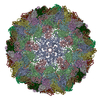
|
- Components
Components
| #1: Protein | Mass: 32564.445 Da / Num. of mol.: 11 / Source method: isolated from a natural source / Source: (natural)  Echovirus E18 / Cell line: GMK / References: UniProt: Q8V635 Echovirus E18 / Cell line: GMK / References: UniProt: Q8V635#2: Protein | Mass: 26143.783 Da / Num. of mol.: 11 / Source method: isolated from a natural source / Source: (natural)  Echovirus E18 / Cell line: GMK / References: UniProt: Q8V635 Echovirus E18 / Cell line: GMK / References: UniProt: Q8V635#3: Protein | Mass: 28674.199 Da / Num. of mol.: 11 / Source method: isolated from a natural source / Source: (natural)  Echovirus E18 / Cell line: GMK / References: UniProt: Q8V635 Echovirus E18 / Cell line: GMK / References: UniProt: Q8V635Has protein modification | Y | |
|---|
-Experimental details
-Experiment
| Experiment | Method: ELECTRON MICROSCOPY |
|---|---|
| EM experiment | Aggregation state: PARTICLE / 3D reconstruction method: single particle reconstruction |
- Sample preparation
Sample preparation
| Component | Name: Echovirus E18 / Type: VIRUS / Entity ID: all / Source: NATURAL | ||||||||||||||||||||
|---|---|---|---|---|---|---|---|---|---|---|---|---|---|---|---|---|---|---|---|---|---|
| Molecular weight | Value: 7.20 MDa / Experimental value: NO | ||||||||||||||||||||
| Source (natural) | Organism:  Echovirus E18 / Strain: Metcalf Echovirus E18 / Strain: Metcalf | ||||||||||||||||||||
| Details of virus | Empty: NO / Enveloped: NO / Isolate: STRAIN / Type: VIRION | ||||||||||||||||||||
| Natural host | Organism: Homo sapiens | ||||||||||||||||||||
| Virus shell | Name: Capsid / Diameter: 340 nm / Triangulation number (T number): 1 | ||||||||||||||||||||
| Buffer solution | pH: 6 | ||||||||||||||||||||
| Buffer component |
| ||||||||||||||||||||
| Specimen | Conc.: 0.5 mg/ml / Embedding applied: NO / Shadowing applied: NO / Staining applied: NO / Vitrification applied: YES | ||||||||||||||||||||
| Specimen support | Grid material: COPPER / Grid mesh size: 300 divisions/in. / Grid type: Quantifoil R2/1 | ||||||||||||||||||||
| Vitrification | Instrument: FEI VITROBOT MARK IV / Cryogen name: ETHANE / Humidity: 100 % / Chamber temperature: 298 K |
- Electron microscopy imaging
Electron microscopy imaging
| Experimental equipment |  Model: Titan Krios / Image courtesy: FEI Company |
|---|---|
| Microscopy | Model: FEI TITAN KRIOS |
| Electron gun | Electron source:  FIELD EMISSION GUN / Accelerating voltage: 300 kV / Illumination mode: FLOOD BEAM FIELD EMISSION GUN / Accelerating voltage: 300 kV / Illumination mode: FLOOD BEAM |
| Electron lens | Mode: BRIGHT FIELD / Nominal magnification: 75000 X / Calibrated magnification: 79575 X / Nominal defocus max: 3000 nm / Nominal defocus min: 1000 nm / Calibrated defocus min: 651 nm / Calibrated defocus max: 3282 nm / Cs: 2.7 mm / C2 aperture diameter: 50 µm / Alignment procedure: ZEMLIN TABLEAU |
| Specimen holder | Cryogen: NITROGEN / Specimen holder model: FEI TITAN KRIOS AUTOGRID HOLDER |
| Image recording | Average exposure time: 1 sec. / Electron dose: 45.2 e/Å2 / Detector mode: INTEGRATING / Film or detector model: FEI FALCON III (4k x 4k) / Num. of grids imaged: 1 / Num. of real images: 6331 Details: Images were collected in movie-mode at 39 frames per second |
| Image scans | Sampling size: 14 µm / Width: 4096 / Height: 4096 |
- Processing
Processing
| EM software |
| ||||||||||||||||||||||||||||||||||||||||
|---|---|---|---|---|---|---|---|---|---|---|---|---|---|---|---|---|---|---|---|---|---|---|---|---|---|---|---|---|---|---|---|---|---|---|---|---|---|---|---|---|---|
| CTF correction | Type: PHASE FLIPPING ONLY | ||||||||||||||||||||||||||||||||||||||||
| Particle selection | Num. of particles selected: 509565 | ||||||||||||||||||||||||||||||||||||||||
| Symmetry | Point symmetry: C5 (5 fold cyclic) | ||||||||||||||||||||||||||||||||||||||||
| 3D reconstruction | Resolution: 3.8 Å / Resolution method: FSC 0.143 CUT-OFF / Num. of particles: 3563 / Algorithm: BACK PROJECTION / Num. of class averages: 1 / Symmetry type: POINT | ||||||||||||||||||||||||||||||||||||||||
| Atomic model building | B value: 131.32 / Protocol: RIGID BODY FIT / Space: RECIPROCAL / Target criteria: R-factor / Details: Group B-factor refinement | ||||||||||||||||||||||||||||||||||||||||
| Atomic model building | PDB-ID: 6HBH Accession code: 6HBH / Source name: PDB / Type: experimental model |
 Movie
Movie Controller
Controller





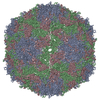

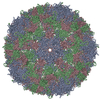
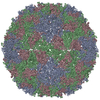
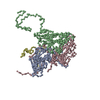
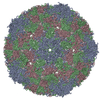
 PDBj
PDBj

